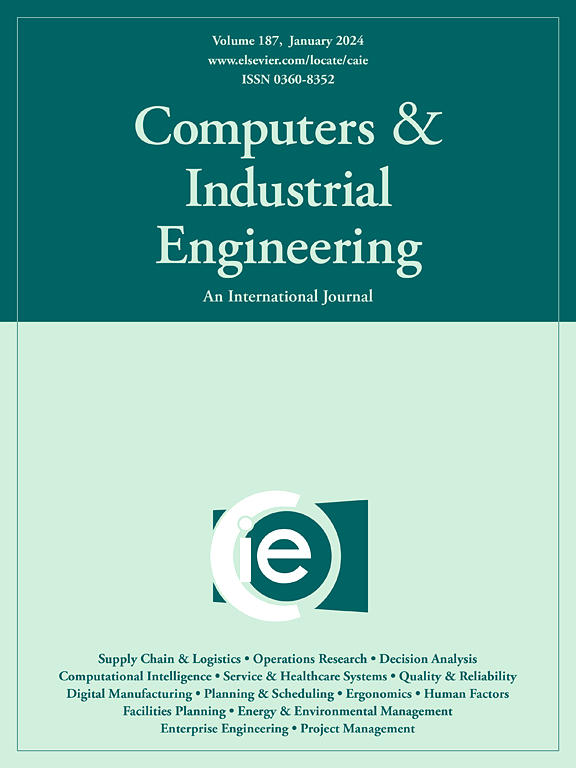How does dual-credit policy regulate competitive fuel vehicle and new energy vehicle manufacturers? based on operational decision analysis under multiple scenarios
IF 6.7
1区 工程技术
Q1 COMPUTER SCIENCE, INTERDISCIPLINARY APPLICATIONS
引用次数: 0
Abstract
This article investigates the remarkable impacts of the dual-credit policy (DCP) on fuel vehicle (FV) and new energy vehicle (NEV) automakers, and considers the competition for emission reduction between FVs and NEVs. We apply the game-theoretic approach to design four scenarios, i.e., no DCP, DCP to regulate NEV automakers, DCP to regulate FV automakers, and DCP to regulate dual automakers. The study reveals that increasing the credit trading price reduces the emission reduction level for FVs but not for NEVs. When the DCP regulates NEV automakers, the credit trading price positively correlates with the automaker’s profit. An increase in each NEV credit boosts the emission reduction level of NEVs and automakers’ profits. Conversely, an increase in the NEV credit ratio lowers the emission reduction level of FVs. The higher the credit trading price, each NEV credit and NEV credit ratio contribute to reducing the total carbon emission level. Meanwhile, the total carbon emission level is the lowest in the scenario of DCP regulating dual automakers, but the automakers’ profits will suffer some losses. Also, the scenario of DCP regulating NEV automakers to achieve the highest profits will result in a higher carbon emission level. Moreover, the main contribution of this study is to identify the business performance of DCP regulating single or dual automakers, while simultaneously pointing out the effective choices for DCP to promote the green operations of competing automakers. Our results suggest some novel management recommendations for automakers and governments that can contribute to enhancing the sustainability of the automotive industry.
双积分政策如何调控燃油车和新能源车竞争厂商?基于多场景下的运营决策分析
本文研究了双积分政策对燃油车和新能源车制造商的显著影响,并考虑了燃油车和新能源车在减排方面的竞争。运用博弈论的方法,设计了无DCP、DCP对新能源汽车制造商的监管、DCP对混合动力汽车制造商的监管和DCP对双厂商的监管四种场景。研究表明,提高信用交易价格可以降低纯电动汽车的减排水平,但对新能源汽车没有影响。当DCP调控新能源汽车制造商时,信用交易价格与汽车制造商的利润呈正相关。每一项新能源汽车信用额度的增加,都会提高新能源汽车的减排水平和汽车制造商的利润。相反,新能源汽车信贷比例的增加降低了燃料汽车的减排水平。信用交易价格越高,每个新能源汽车信用额度和新能源汽车信用比率对降低总碳排放水平的贡献越大。同时,DCP调控双车情景下的总碳排放水平最低,但汽车制造商的利润会受到一定损失。此外,DCP为实现最高利润而对新能源汽车制造商进行监管的情景将导致更高的碳排放水平。此外,本研究的主要贡献在于识别了DCP对单一或双重汽车制造商的经营绩效,同时指出了DCP促进竞争对手汽车制造商绿色运营的有效选择。我们的研究结果为汽车制造商和政府提出了一些新的管理建议,有助于提高汽车工业的可持续性。
本文章由计算机程序翻译,如有差异,请以英文原文为准。
求助全文
约1分钟内获得全文
求助全文
来源期刊

Computers & Industrial Engineering
工程技术-工程:工业
CiteScore
12.70
自引率
12.70%
发文量
794
审稿时长
10.6 months
期刊介绍:
Computers & Industrial Engineering (CAIE) is dedicated to researchers, educators, and practitioners in industrial engineering and related fields. Pioneering the integration of computers in research, education, and practice, industrial engineering has evolved to make computers and electronic communication integral to its domain. CAIE publishes original contributions focusing on the development of novel computerized methodologies to address industrial engineering problems. It also highlights the applications of these methodologies to issues within the broader industrial engineering and associated communities. The journal actively encourages submissions that push the boundaries of fundamental theories and concepts in industrial engineering techniques.
 求助内容:
求助内容: 应助结果提醒方式:
应助结果提醒方式:


